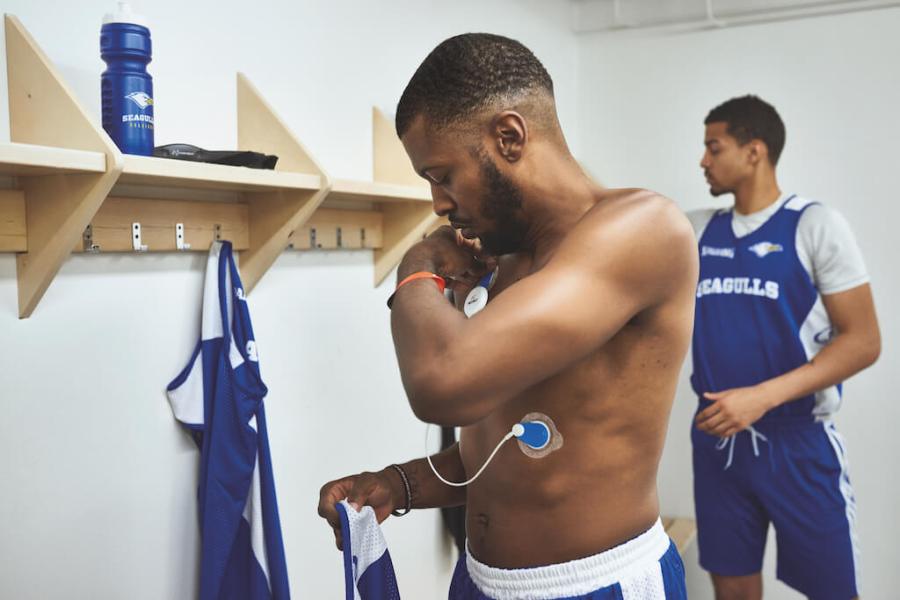“When you have good HRV, it means your body and heart are able to respond to different demands.”
When it comes to maintaining an effective training regime, understanding how life’s stressors – work, cooking, putting the kids to bed – impact your body’s requirements for recovery is essential.
But how do we know what daily factors cause us the most stress and, importantly, if we are effectively recovering from them?
Say hello to Heart Rate Variability (HRV) – in short, the measure of variation in milliseconds between each successive heartbeat.
While acknowledgement of this natural occurrence is far from new, those outside the medical community are only recently becoming aware that, by analysing how HRV fluctuates throughout the day, we can garner a wealth of information with regards to our training, fitness and health.
“When you have good HRV, it means your body and heart are able to respond to different demands”, explains Tiina Hoffman, exercise physiologist at performance analytics company Firstbeat.
Your HRV is a reflection of how quickly your body reacts to a stimulus: a high figure is considered good and a low figure is less desirable. Professional athletes are able to recover faster and better, as their heart rate returns to resting quicker; whereas the heart rate of a less fit individual stays more regular, indicating continued stress.
You can thank (or blame) your parents for some of yours: “around 30 per cent of a person’s HRV is genetically determined,” says Hoffman. However, the remaining 70 per cent is impacted by a host of external factors – all of which can have bigger repercussions than you might expect.

“The most important and often most overlooked area for athletic progression is recovery”
Rest Test
One of the key elements HRV highlights is the vital role sleep and recovery play in achieving and maintaining good performance.
“The most important and often most overlooked area for athletic progression is recovery – and sleep quality is key,” states Dave Ryding, alpine ski racer for Team GB. Indeed, research shows poor sleep can lead to decreased energy, concentration, speed and accuracy during exercise and, when it comes to health, increased risk of heart disease, diabetes, obesity and depression.
“Whether you’re a professional or recreational athlete, if you don’t sleep well and recover, it’s very difficult to maintain any kind of hard training regime,” Hoffman adds.
Your HRV reveals whether you’ve had a bad night’s sleep and, if so, figures from the previous day can indicate what may have affected it. “From there, [you can] look at things to help improve sleep,” says Hoffman. “Alcohol, for example, is a talking point. When you have several drinks in the evening, almost without exception, sleep is far worse.”
Culinary decisions can send you into a negative cycle, too. “If you’re not eating enough, or eating poor quality food, this increases your stress level during the day, which affects sleep quality in a negative way,” states Hoffman. Meal times can also affect athletic recovery, reveals Jai Geyer, alpine ski coach for Team GB. For his athletes during the World Cup Tour, he requests “an earlier dinner, [to] allow the winding down process to start earlier, improving sleep.”
Knowledge is Power
In addition to helping us understand how nutrition impacts sleep, HRV analysis provides a view into the relationship between the functionality of our workouts and recovery. For example, you may discover those after-work gym sessions are having a less-than-desired-effect on your already overloaded body.
“If you do HIIT later in the evening, it will usually have a dramatic impact on sleep that night,” says Hoffmann.
While exercising later in the day sometimes can’t be avoided, Hoffman says: “You need to understand you have to take it easy the next day and get optimum sleep the following night.”
As your fitness level increases, so does your body’s requirement for restorative sleep. It is vital, therefore, to increase your knowledge and take action.
“If we’re interested in what we’re ‘doing’, we should also be interested in monitoring what we’re not doing,” says Geyer. “Identifying stressors, and using strategies to minimise them and improve your response to them, can make a difference.”

“HRV analysis is equally suitable for anyone doing endurance, power or speed sports”
Insights for All
As Hoffman explains, “During training, your heart rate increases and the variation isn’t there. It’s the time after that’s meaningful” – which makes HRV analysis equally suitable for anyone doing endurance, power or speed sports.
The technology that interprets HRV is similar to that of a heart-rate monitor, except “the accuracy required means it detects every beat of the heart and measures the time between [each beat]. This requires a more sophisticated kind of device and algorithms,” explains Hoffman.
Elite athletes and teams have had access to state-of-the-art HRV analysis for a while but, in the last few years, it has become more accessible to ‘corporate athletes’ (those who take their fitness very seriously and regularly compete in marathons and triathlons) and regular gym-goers.
If you’re after a more detailed HRV insight, then a professional-led analysis is an option. A number of healthcare providers, personal trainers, nutritionists and psychologists offer this service to their clients through programmes such as Firstbeat’s Lifestyle Assessment.
Over several days, the user wears a small monitor which very accurately detects heartbeat, and is required to log notable behaviour such as training sessions or drinking alcohol. Afterwards, a report is generated which provides a broader insight into their lifestyle and health, “so they can make training more effective,” explains Hoffman.
However, for a quicker or briefer overview, leading brands such as Garmin, Suunto, Polar and Fitbit have integrated forms of HRV analysis into their wearable trackers. Hoffman notes, however, “This tech is more of an estimation of the pulse from the blood flow in the wrist. It’s not as accurate, but improving constantly.”
While your HRV can provide valuable insights into your health and training, it’s important to remember that balance is key – and its figures aren’t all you should take into account. A number of other factors, such as cholesterol and blood pressure, are fundamental to good physical health and aren’t disclosed by your heart rate.
Have Heart
But as people become increasingly interested in optimising their health and training regime, HRV analysis affords a solid basis from which they can learn.
“It can be a catalyst for making better decisions, as it shifts our focus to freshness, recovery and wellbeing,” says Geyer.
“I wouldn’t say it’s mainstream yet,” she adds, but she is confident HRV technology will “become more available, so people can get the valuable insights they need.”
Words: Chantelle Pattemore








